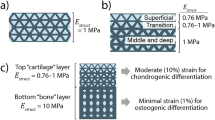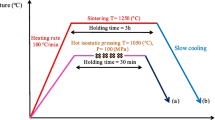Abstract
In this study, we propose an integrated approach which combines 3D printing and liquid precursor infiltration together to prepare alumina-toughened zirconia (ATZ) composite. Controllable manipulation of the microstructure of the composite could be realized through different infiltration times and sintering temperature. The 3D-printed ATZ with infiltration and post-CIP sintered at 1550 °C possesses the highest relative density (98.11%), hardness (12.65 ± 0.24 GPa) and fracture toughness (6.42 ± 0.33 MPa m1/2). The rates of increase in the performance compared with the undoped zirconia sintered at 1550 °C are 1.8%, 8.4% and 34.6%, respectively. The dominated toughening mechanism of ATZ could be attributed to the effect of Al2O3 inclusion on crack deflection and energy absorption. The 3D-printed ATZ sample with infiltration followed by CIP sintered at 1550 °C shows the lowest aging rate and the lowest phase transformation depth compared with 3Y-TZP (Tetragonal Zirconia Polycrystal). Our integrated approach could not only realize the complex and ultrafine shape free of molds, but also suppress the low temperature aging behavior of dental implants, which has baffled dentists for a long time.













Similar content being viewed by others
References
Chaim R (1992) Pressureless sintered ATZ and ZTA ceramic composites. J Mater Sci 27:5597–5602. https://doi.org/10.1007/BF00541629
Matsui K, Nakamura K, Kumamoto A, Yoshida H, Ikuhara Y (2016) Low-temperature degradation in yttria-stabilized tetragonal zirconia polycrystal doped with small amounts of alumina: effect of grain-boundary energy. J Eur Ceram Soc 36:155–162
Lughi V, Sergo V (2010) Low temperature degradation-aging-of zirconia: a critical review of the relevant aspects in dentistry. Dent Mater 26:807–820
Muñoz-Saldaña J, Balmori-Tamirez H, Jaramillo-Vigueras D, Iga T, Schneider GA (2003) Mechanical properties and low-temperature aging of tetragonal zirconia polycrystals processed by hot isostatic pressing. J Mater Res 18:2415–2426
Ardlin BI (2002) Transformation-toughened zirconia for dental inlays, crowns and bridges: chemical stability and effect of low-temperature aging on flexural strength and surface structure. Dent Mater 18:590–595
Liu GW, Xie ZP, Wu Y (2011) Fabrication and mechanical properties of homogeneous zirconia toughened alumina ceramics via cyclic solution infiltration and in situ precipitation. Mater Des 32:3440–3447
Marple BR, Green DJ (1993) Graded compositions and microstructures by infiltration processing. J Mater Sci 28:4637–4643. https://doi.org/10.1007/BF00414252
Glass SJ, Green DJ (2010) Mechanical properties of infiltrated alumina-Y-TZP composites. J Am Ceram Soc 79:2227–2236
Zocca A, Colombo P, Gomes CM, Gunster J (2015) additive manufacturing of ceramics: issues, potentialities, and opportunities. J Am Ceram Soc 98:1983–2001
Song X, Chen Y, Lee TW, Wu SH, Cheng LX (2015) Ceramic fabrication using mask-image-projection-based stereolithography integrated with tape-casting. J Manuf Process 20:456–464
Yang Y, Chen ZY, Song X, Zhu BP, Hsiai T, Wu PI, Xiong R, Shi J, Chen Y, Zhou QF, Shung KK (2016) Three dimensional printing of high dielectric capacitor using projection based stereolithography method. Nano Energy 22:414–421
Xing HY, Zou B, Li SS, Fu XS (2017) Study on surface quality, precision and mechanical properties of 3D printed ZrO2 ceramic components by laser scanning stereolithography. Ceram Int 43:16340–16347
Rosa M, Barou C, Esposito V (2018) Zirconia UV-curable colloids for additive manufacturing via hybrid inkjet printing-stereolithography. Mater Lett 215:214–217
Liu W, He R, Wu H, Tian Z, Li Y, Huang M, Liang J, An D, Li H, Xie Z, Wu S (2018) Typical features of DLP-SLA-based 3D printing technique of submicron alumina with ultra-high purity. J Mater Sci (under review)
An D, Liu W, Xie ZP, Li HZ, Luo XD, Wu HD, Huang MP, Liang JW, Tian Z, He RX (2018) A strategy for defects heal in 3D printed ceramic compact via CIP: sintering kinetic window and microstructure evolution. J Am Ceram Soc. https://doi.org/10.1111/jace.16269
Zhou MP, Liu W, Wu HD, Song X, Chen Y, Cheng LX, He FP, Chen S, Wu SH (2016) Preparation of a defect-free alumina cutting tool via additive manufacturing based on stereolithography-optimization of the drying and debinding processes. Ceram Int 42:11598–11602
Evans AG, Charles EA (1976) Fracture toughness determination by indentation. J Am Ceram Soc 59:371–372
Garvie RC, Nicholson PS (1972) Phase analysis in zirconia systems. J Am Ceram Soc 55:303–305
Toraya H, Yoshimura M, Somiya S (1984) Calibration curve for quantitative analysis of the monoclinic-tetragonal ZrO2 system by x-ray diffraction. J Am Ceram Soc 67:C119–C121
Kosmač T, Kocjan A (2012) Ageing of dental zirconia ceramics. J Eur Ceram Soc 32:2613–2622
Liu GW, Xie ZP, Wu Y (2010) Effectively inhibiting abnormal grain growth of alumina in ZTA with low-content fine-sized ZrO2 inclusions introduced by infiltration and in situ precipitation. J Am Ceram Soc 93:4001–4004
Hodgson SNB, Cawley J, Clubley M (1999) The role of Al2O3 impurities on the microstructure and properties of Y-TZP. J Mater Process Technol 92–93:85–90
Liu GW, Xie ZP, Wang W et al (2011) Fabrication of ZrO2–CoAl2O4 composite by injection molding and solution infiltration. Int J Appl Ceram Technol 8:1344–1352
Liu GW, Xie ZP, Liu W et al (2012) Fabrication of translucent alumina ceramics from pre-sintered bodies infiltrated with sintering additive precursor solutions. J Eur Ceram Soc 32:711–715
Liu GW, Xie ZP, Wu Y (2011) Research progress of manipulating composition and properties of ceramics via liquid precursor infiltration technique. J Inorg Mater 26:1121–1128
Kohorst P, Borchers L, Strempel J, Stiesch M, Hassel T, Bach FW, Hubsch C (2012) Low temperature degradation of different zirconia ceramics for dental applications. Acta Biomater 8:1213–1220
Kawai Y, Uo M, Wang YM, Kono S, Ohnuki S, Watari F (2011) Phase transformation of zirconia ceramics by hydrothermal degradation. Dent Mater 30:286–292
Zhang F, Inokoshi M, Vanmeensel K, Van Meerbeek B, Naert I, Vleugels J (2015) Lifetime estimation of zirconia ceramics by linear ageing kinetics. Acta Mater 92:290–298
Samodurova A, Kocjan A, Swain MV, Kosmac T (2015) The combined effect of alumina and silica co-doping on the ageing resistance of 3Y-TZP bioceramics. Acta Biomater 11:477–487
Zhang F, Batuk M, Hadermann J, Manfredi G, Marien A, Vanmeensel K, Inokoshi M, Van Meerbeek B, Naert I, Vleugels J (2016) Effect of cation dopant radius on the hydrothermal stability of tetragonal zirconia: grain boundary segregation and oxygen vacancy annihilation. Acta Mater 106:48–58
Acknowledgements
This work was financially supported by the Science and Technology Project of Guangdong Province (Grant Nos. 2016B090915002 and 2017A010103046), National Natural Science Foundation of China (NSFC, Grant No. 51872052), Pearl River S and T Nova Program of Guangzhou (Grant No. 201806010173), Guangdong Innovative and Entrepreneurial Research Team Program (Grant No. 2016ZT06G375), and the open fund of State Key Laboratory of New Ceramic and Fine Processing Tsinghua University.
Author information
Authors and Affiliations
Corresponding authors
Additional information
Publisher's Note
Springer Nature remains neutral with regard to jurisdictional claims in published maps and institutional affiliations.
Rights and permissions
About this article
Cite this article
Wu, H., Liu, W., Lin, L. et al. Preparation of alumina-toughened zirconia via 3D printing and liquid precursor infiltration: manipulation of the microstructure, the mechanical properties and the low temperature aging behavior. J Mater Sci 54, 7447–7459 (2019). https://doi.org/10.1007/s10853-019-03432-9
Received:
Accepted:
Published:
Issue Date:
DOI: https://doi.org/10.1007/s10853-019-03432-9




